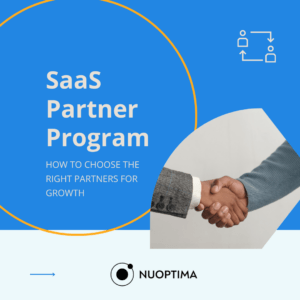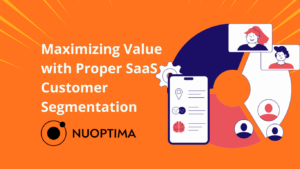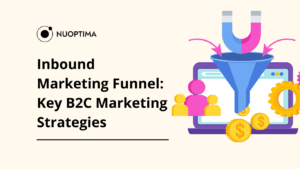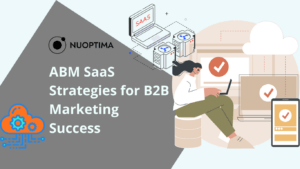The SaaS marketing funnel isn’t as linear as marketers would love.
Especially when we’re talking about B2B SaaS marketing.
If you’re working in digital marketing for SaaS or you’re a business owner, you’ve read countless articles about top-of-the-funnel, middle-of-the-funnel, and bottom-of-the-funnel strategies.
Right?
But did you know that 71% of leads never convert into sales[1], largely due to a lack of effective nurturing?
Different websites have different names for the same thing—how to build an engine that gets you new customers almost on autopilot?
Because that’s what the SaaS marketing funnel should be all about – increasing your user base, reducing churn, and increasing your annual recurring revenue year after year.
Ready to dive in and learn how to create a high-performing SaaS marketing funnel? Let’s explore the essential stages and strategies to optimize each step of the journey.
High-Performing SaaS Marketing Funnel: TLDR
| Realize that 99% of potential customers aren’t ready to buy immediately. Design a flexible SaaS funnel that accommodates their non-linear journey and provides consistent, valuable information across various channels. |
| TOFU | MOFU | BOFU |
| Capture attention with content marketing and SEO. Use in-depth guides, long-tail keywords, and regular blog updates. Leverage link building through guest posts, SaaS partnership strategies, and creating linkable assets. | Engage prospects with webinars, case studies, and detailed product pages. Focus on specific use cases and industry needs. Provide free trials and freemium models with excellent onboarding and personalized support. | Convince potential customers with paid advertising and comparison guides. Highlight real data, user reviews, and unique benefits of your product without directly linking to competitors. |
| Retain and transform customers into loyal advocates through effective onboarding, customer success programs, and continuous engagement. Use tools like Appcues for personalized onboarding, Intercom for in-app support, and Userpilot for interactive tutorials. |
The Truth About SaaS Funnels: How Your Customers Buy vs How You Think They Buy
If you want to build a B2B SaaS marketing funnel, the first hard truth you need to get on terms with is that 99% of your potential customers aren’t ready to buy.
Often, there’s a disconnect between how businesses think their customers buy and the actual journey the customers go through.
Understanding the reality of how your customers buy is crucial to designing a scalable SaaS marketing plan.
Traditional View of SaaS Funnels
Most marketers visualize the SaaS funnel as a straightforward, linear process.
It starts when potential customers first become aware of your product, and they are in the awareness stage of the SaaS customer journey. This is what is widely accepted as the top of the funnel.
After that, they move closer to the middle of the funnel and into the consideration stage, where they evaluate their options.
The decision stage and bottom of the funnel are next on the list, and that’s when the purchase happens.
But is that really how things happen?
The Real SaaS Funnel
In reality, the journey is far from linear.
Potential customers jump back and forth between stages, revisit the same information multiple times, or even abandon the process temporarily.
57% of the B2B purchases are completed before a customer even talks to a vendor..[2] This means your marketing funnel needs to accommodate a more dynamic, flexible buying process.
Key Factors Influencing Marketing Funnel for SaaS Companies
|
Customers interact with your brand across various channels—blogs, social media, email campaigns, webinars, and more. Each SaaS product marketing initiative needs to provide consistent and valuable information to nurture the lead effectively. For SaaS business founders looking to deepen their understanding of these processes, check out our list of SaaS books that cover these topics in detail. Buyers consume a significant amount of content before making a decision. On average, a B2B customer engages with 13 pieces of content before making a purchase [3]. This highlights the importance of having a robust content strategy that addresses different stages of the buyer’s journey. Recommendations and reviews from peers play a crucial role in the decision-making process. Encouraging satisfied customers to share their positive experiences can significantly impact potential buyers. To bridge the gap between how you think your customers buy and how they actually buy, you need to create a flexible, omnichannel approach that addresses the diverse paths your customers might take. For niche products like micro SaaS, understanding the specific customer journey is even more critical. This means continually analyzing customer behavior, gathering feedback, and optimizing your funnel to better align with their journey. |
Stages of The SaaS Funnel You Have To Dominate & How
While the traditional view of the B2C and B2B SaaS sales funnels is still relevant, the specific strategies for truly dominating each funnel stage have evolved.
Top of the Funnel
The goal of this stage is simple – capture the attention of potential customers. But the trick is, that you’ll have a lot of people who enter your funnel, but only a few that come to the end.
The quality of the top-of-the-funnel stage determines whether you get more than enough customers at the bottom of the funnel. So don’t skip it!
Strategies:
And how do you achieve that? With strategies that work for a B2B SaaS funnel that’s not perfect but represents how your potential customers buy, today.
Content Marketing & SEO
62% of B2B buyers use search as one of the first ways to learn more about your solution. [4]
Those are people who need what your product has to offer.
But you have to warm them up better than competitors if you want to move them further down the funnel.
Content marketing and SEO are great strategies to achieve this, but you have to do it better than your competitors.
So don’t mindlessly chase every keyword with decent search volume and write blogs.
Be smarter than that.
Conduct SME (Subject Matter Expert) interviews, talk to your customers, and discover their true problems and how your product solves them. While talking to them, listen closely to the language they use and how they describe your solution.
Then, you can use tools like SemRush and Ahrefs to conduct comprehensive keyword research and pick only the highly relevant keywords. And you’ll know that based on field data from your actual customers, not some algorithm.
That’s the strategic part – and a vital step your competitors often skip.
Once you’ve talked to the customers, it’s time to roll up your sleeves and use their input to produce some actual results.
But how?
When it comes to SEO content, you should:
- Maintain a consistent publishing schedule to keep your audience engaged and signal to search engines that your site is active.
- Address common pain points and provide detailed solutions that showcase your expertise and the benefits of your product.
- Focus on long-tail keywords specific to your niche to attract highly targeted traffic and improve your chances of ranking.
Keyword examples:
- What is customer support software
- Benefits of a helpdesk system
- How to improve customer service
- Live chat best practices
- Handling customer complaints
- How to recruit top talent
- Benefits of HR software
- Employee onboarding process
- Talent management strategies
- Payroll processing tips
- How to protect data online
- Benefits of antivirus software
- Network security basics
When it comes to SaaS link building, you should:
- Write guest articles for reputable sites in your industry to build high-quality backlinks and drive referral traffic.
- Collaborate with complementary businesses for co-marketing efforts and mutual backlink opportunities.
- Create linkable assets such as infographics, whitepapers, and original research that others want to link to.
Middle of the Funnel
In the middle of the funnel, your SaaS product takes the stage.
The good news is – your customers know the solution to their problem.
The bad news is – you’re not the only one offering it.
Strategies:
How do you make them choose you over your competitors?
And we’re not only talking about direct competitors who offer the same features.
We’re also talking about your content competitors, competitors who target the same market segment with different products, etc.
You have to outsmart them all, and here is how:
Webinars
Hosting webinars is an effective way to showcase how your product solves specific problems for specific market segments.
Webinars need to be highly targeted and to the point. For example, instead of hosting webinars:
- Boosting Sales and Customer Retention with [Your Product]
- Maximizing Team Productivity with [Your Product]
- Automating Your Marketing for Better ROI with [Your Product]
- Simplifying Financial Management for Small Businesses with [Your Product]
You can create webinar series that are highly relevant to the high-value buyer persona you target:
- How to Boost Sales & Customer Retention for Your Webflow Agency
- How to Maximize Product Development Productivity with Agile Project Management
- How to Automate Listing Marketing for Faster Sales
- How to Simplify Financial Management for Your Architecture Studio
For example, as a SaaS SEO Agency, we hosted a webinar series, “SEO Accelerator,” and generated 568 qualified leads and closed £90k in contracts.
It was never about closing revenue for us, but about educating potential clients about SEO’s value, leveraging social proof, and creating a seamless sign-up process with referral incentives.
But that’s just how it goes; we provided value and got some amazing results in return!
Case Studies
Publishing detailed case studies that highlight how your product has helped other businesses is the best way to demonstrate its value and justify its price.
Once again, you don’t want to create non-specific case studies. Instead, focus on creating at least one case study for each market segment you target. The case study should cover:
- The problem your customer faced before coming across your product.
- The process they went through to resolve that problem.
- The results they achieved with your product, but with a strong focus on highly relevant pain points.
For example, a real estate agent struggled with listings being too long on the market because they didn’t have enough time to devote to marketing, but your marketing automation product solved that, and now they sell houses 56% faster.
And when you spice up these case studies with video testimonials to boost credibility, you’ll get more customers to the bottom of the funnel than ever.
Free Trials & Freemium Models
Are freemium models and free trials race to the bottom?
Are they the last resort for unsuccessful SaaS products?
Should you focus on gaining free signups and hope they convert?
The answer to all these questions is no, but only when you do it the right way.
Offering free trials or a freemium version of your product allows potential customers to experience its benefits firsthand. This hands-on approach can significantly increase the chances of conversion as it lets users evaluate the product’s value without any initial commitment.
It’s a no-brainer for customers.
But using something for free is completely different than paying for it.
There are two solutions to that:
- Data
- Onboarding
Design an intuitive and supportive onboarding experience to help users get started quickly and see the value of your product. Provide guides, tutorials, and customer support to assist users during their trial period.
You basically have to “buy” your customers by providing them with the best onboarding experience, and then they’ll buy from you.
When it comes to data, you have to be smart about it.
- Use analytics to monitor user engagement and set triggers for personalized communication. For example, if a user hasn’t engaged with a critical feature, send them a helpful tutorial or offer a one-on-one demo.
- Throughout the trial period, subtly highlight the additional features and benefits of your premium plans. Use in-app messages and emails to remind users what they’re missing out on by not upgrading.
- Provide limited-time discounts or special offers to encourage users to upgrade before their trial period ends. This creates a sense of urgency and can significantly boost SaaS conversion rates.
For example, Slack reminds users of the limitations of the free plan, such as limited message history and integrations, while showcasing the advantages of their paid plans.
Detailed Product Pages
The first thing you need to get right is how to categorize your product pages. If you want to build a successful B2B SaaS funnel, you have to go all-in on multiple fronts.
| By Product Type | By Industry | By Use Case | By Feature |
| Make it easy for users to find products based on what they are looking for. | Tailor content to industry-specific needs and language. | Showcase howto use your product to solve specific problems or achieve particular goals. | Highlight and provide detailed information about specific features. |
| Adobe Creative Cloud categorizes products by type, such as “Design,” “Photography,” “Video,” etc. | Salesforce offers industry-specific solutions with dedicated pages for “Financial Services Cloud,” “Healthcare CRM,” etc. | Trello has pages for different use cases like “Project Management,” “Task Management,” and “Team Collaboration.” | HubSpot’s CRM has feature-specific pages such as “Lead Management,” “Sales Automation,” and “Pipeline Management,” each providing in-depth details and benefits. |

Tools:
- Unbounce – building high-converting SaaS landing pages.
- Hotjar – for recording user sessions and analyzing how users interact with your product pages to identify areas for improvement.
Bottom of the Funnel
Convince potential customers to choose your product.
Strategies:
Paid Advertising
Paid advertising is how you fight with competitors for that 1% of the customers who are ready to buy.
It generates results quickly, but it’s a short-term strategy. The methodology is simple – as long as you pay, you get leads.
But it’s not easy.
The quality of your paid advertising campaigns is what determines the quality of your leads. It directly influences your SaaS ROI, and you shouldn’t mess with campaign setup if you want great results.
Pay Per Click advertising will quickly drain your budget because in the SaaS industry, cost per click can get really high quickly.

For example, the cost per click for “HR software” is almost $36. But how many clicks do you need to pay for to get just one customer?
Well, definitely not one.
That’s why you need SaaS experts to run your campaigns.
And with a SaaS PPC agency that achieves high ROI and even higher ROAS (Return on Ad Spend), you’ll get the most out of your budget.
Comparison Guides
Rest assured, when your potential customers are searching for:
- Alternatives to
- The best XY software
- Product vs Product
And other articles that compare two or more SaaS solutions, they’re actually looking for a reason not to buy from you. Actually, for a reason not to buy at all.
They want your product for free, which is old news. Everyone loves free stuff. But the good news is they are actually aware they need your product or something similar.
It’s on you to convince them it’s worth their hard-earned money.
And we’ve prepared actionable tips you can implement right away to write a comparison guide that converts:
- Provide a balanced overview of each alternative, highlighting key features, pros, and cons.
- Always include your product at the top. Users are lazy, and they often decide to try the first solution. That’s your chance to convert them fast.
- Provide comparisons based on real data or user reviews.
For example, according to user reviews on G2, [Your Product] scores higher in customer support than [Competitor].
- Summarize why your product is the best choice and include a call to action.
- Never link to competitors.
- Briefly outline the criteria used for selecting the best software (e.g., features, pricing, user reviews).
- Add testimonials or quotes from satisfied customers to build trust.
Which tools will help you cover all these strategies with high efficiency?
- G2 & Capterra to gather and showcase user reviews and comparisons.
- Google Ads for running Pay Per Click Campaigns.
- LinkedIn Ads for effective B2B SaaS advertising.
What Happens After They Go Through Your SaaS Funnel?
Congratulations, customers have successfully gone through your funnel and purchased your SaaS product.
But is your job done here?
Nope!
Now, you need to focus on retaining existing customers and transforming them into loyal advocates who can drive referrals and positive word-of-mouth for your brand.
And it only gets better because referrals convert 30% better than leads from other marketing channels.[5]
This stage is crucial for ensuring long-term business success, as retaining customers is often more cost-effective than acquiring new ones. Moreover, loyal customers can provide valuable feedback and help improve your product.
Onboarding
B2B SaaS onboarding needs to be on point if you want your customers to stay and pay.
For less complex solutions, you can implement the self-serve onboarding process. More complex solutions require a hands-on approach to onboarding, and you want to have a dedicated team to do it.
Your success depends on your customer’s success with your product.
Teach them how to succeed with:
- Personalized onboarding process based on user data and behavior. Send them a quick survey to find out more about their business and pain points to customize the onboarding to their needs.
- Product walkthroughs and interactive tutorials they can go through immediately after logging in.
- Links to appropriate documentation next to every feature.
- Responsive customer support that doesn’t take 4 days to respond.
Tools you can use to become a better SaaS vendor are:
- Appcues – creating personalized onboarding experiences.
- Intercom – providing in-app messaging and support.
- Userpilot – building interactive onboarding flows.
Conclusion
The SaaS marketing funnel shouldn’t be about tricking users into purchasing your product and calling it a successful transaction.
What happens after your customers go through the traditional stages of the B2B SaaS sales funnel is even more important.
It’s because when you care only about selling, it’s short-term gain. And your funnel’s goal is to bring you sustainable growth and long-term success.
To visualize the reality of how your customers buy, you need to ditch the traditional view of the funnel. Forget about linear.
Strategies for creating an effective funnel may seem the same as they did 10 years ago. But they aren’t. As the competition grew, so did the buyer’s expectations.
That’s why you need to talk to your customers as the first step and only then use strategies for the top of the funnel, middle of the funnel, and bottom of the funnel.
At the top of the funnel, focus on content marketing and SEO to capture attention and drive organic traffic. Create valuable content that addresses the pain points of your target audience and optimize it for search engines.
In the middle of the funnel, engage prospects through webinars, detailed case studies, and comprehensive product pages that showcase your product’s benefits and unique features.
At the bottom of the funnel, utilize paid advertising and product comparisons to convince potential customers of your product’s value. Highlight real user data and reviews to build trust and encourage decision-making.
Post-purchase, focus on customer success and retention by providing ongoing support, personalized communication, and opportunities for engagement.
We get that you may still be confused, and your best bet to beat the competition is to take advantage of a consulting agency specializing in SaaS funnels.
Having worked with hundreds of SaaS businesses, we know exactly what your customers expect from you. And how to make them buy your product.
You can even book a free strategy call to pick our brain and determine the best course of action in your specific circumstances.
FAQ
A SaaS marketing funnel is a strategic model that guides potential customers through the stages of awareness, consideration, decision, and loyalty, aiming to convert them from prospects into loyal, paying users.
To build a SaaS funnel, identify your target audience, create valuable content to attract leads, nurture them through personalized engagement, offer free trials or demos to showcase value, and implement retention strategies to maintain customer loyalty.
The SaaS revenue funnel is a framework that focuses on optimizing each stage of the customer journey to maximize revenue, including lead generation, conversion, onboarding, retention, and upselling or cross-selling opportunities.
The top of the funnel in SaaS refers to the initial stages where potential customers become aware of your product through marketing efforts like content marketing, SEO, social media, and paid advertising.
The activation funnel in SaaS focuses on the steps that turn a new user into an active user, often involving onboarding processes, tutorials, and initial product usage that demonstrate the product’s value and encourage continued engagement.
The B2B sales funnel process involves identifying potential business leads, nurturing them through targeted marketing and personalized interactions, demonstrating the product’s value through demos or trials, and guiding them towards a purchase decision, followed by post-sale support to ensure satisfaction and retention.
References
- https://offers.hubspot.com/sales-trends-report?__hstc=180412856.fc0f3a69d0005da65f524a0b548a4964.1716993045759.1716993045759.1716993045759.1&__hssc=180412856.2.1716993045759&__hsfp=1151451250 [1]
- https://wifitalents.com/statistic/b2b-sales/#:~:text=Nearly%20half%20(49%25)%20of,ranges%20from%20%24116%20to%20%241%2C209.[2]
- https://wifitalents.com/statistic/b2b-sales/ [3]
- https://www.fronetics.com/10-stats-know-b2b-buyers-journey/ [4]
- https://wifitalents.com/statistic/b2b-sales/ [5]



